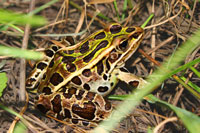Volunteers will learn to identify species as well as protocol for counting.
Click image to enlarge Volunteers will count frogs such as this leopard frog in Illinois from February to June. Photo credit: Thinkstock. |
The state of Illinois is conducting a frog and toad survey orientation January 28 from 1 to 3 p.m. to teach volunteers in the state how to count frogs and toads during the state’s upcoming counts, according to an article in the CarmiTimes. The state holds four frog and toad counts between the months of February and June in an effort to learn more about the status of the state’s frogs and toads as well as their ecology. The volunteers will learn how to distinguish the calls of spring peepers, leopard frogs, American toads, bullfrogs and other species at the orientation, which will be held at the Barkhausen Cache River Wetlands Center. The state has 15 species of frogs and toads within its borders, and of those 15, three species, the cricket frog (Acris crepitans) , Fowlers toad (woodhousii fowleri), and pickerel frog (Rana palustris) have been in steady decline or have disappeared almost completely in the case of the cricket frog.
People interested in volunteering can come to the orientation January 28 from 1 to 3 p.m. at the Barkhausen Cache River Wetlands Center. 8885 State Route 37 South. Orientation and training materials will be handed out to help with counting protocols and species identification. Volunteers will also be assigned one of six routes in the frog and toad survey area. Orientation and training materials will be handed out to help with counting protocols and species identification. Volunteers will also be assigned one of six routes in the frog and toad survey area. For more information, visit www.dnr.illinois.gov.


